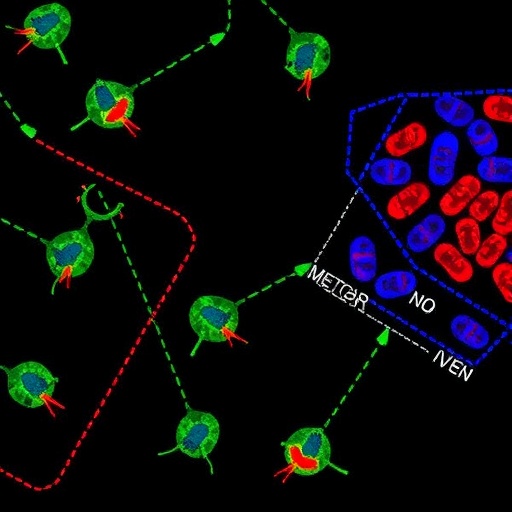In a groundbreaking study published in Nature Chemical Biology, researchers elucidate the transformative potential of intracellular delivery of multivalent binding agents, specifically Intrinsically Disordered Regions (IDRs), in enhancing the efficacy of Chimeric Antigen Receptor T-cells, commonly known as CAR-Ts. This innovative approach addresses a significant challenge in the therapeutic landscape: the treatment of low-antigen tumors, which have traditionally posed a formidable barrier to the success of CAR-T therapies.
The efficacy of CAR-T cells relies fundamentally on their ability to recognize and eliminate cancer cells, a task inherently hindered by the low expression levels of target antigens in certain malignancies. Zhang et al. propose a novel solution whereby IDR-induced condensation of CAR-T cells creates localized, high-density clusters capable of improving their cytotoxic function. By promoting the aggregation of CAR proteins on the T-cell surface, this mechanism enhances the synaptic interactions between CAR-T cells and target cancer cells, thereby boosting the overall cytotoxic response.
The study is rooted in extensive biochemical and biophysical analyses that validate the premise of IDR-mediated condensation. Through the elegant use of fluorescence resonance energy transfer (FRET) techniques, the researchers quantified the effective clustering of CARs driven by IDR modifications. These alterations not only increased the binding affinities of CAR-Ts to cancer antigens but also facilitated a more robust signaling cascade, which is critical for T-cell activation and subsequent tumor lysis.
Clinical implications of this research are substantial. The ability to enhance CAR-T functionalities through biochemical modifications represents a paradigm shift in the treatment approach for cancers characterized by low antigenicity, including certain hematological malignancies and solid tumors. By overcoming a significant drawback that has limited the success of CAR-T therapies, IDR-induced CAR condensation holds the promise of broadening the applicability of this powerful immunotherapeutic modality.
In their experiments, Zhang and colleagues employed various cancer cell lines with differing antigen expression levels. The results demonstrated a striking improvement in the cytotoxic activity of CAR-Ts equipped with IDR modifications, compared to their standard counterparts. Remarkably, even in environments where antigen expression was markedly diminished, IDR-enhanced CAR-Ts exhibited a significant capacity to induce apoptosis, underscoring the potential of this approach in clinical settings.
Moreover, the therapeutic enhancement is not limited to a single tumor type. The versatility of IDR-induced CAR condensation paves the way for potential applications across diverse cancer types. This broad-spectrum efficacy is particularly noteworthy in the realm of personalized medicine. As oncologists increasingly tailor therapies to individual patient profiles, the ability to adapt CAR-T technology may lead to more widespread success rates in previously hard-to-treat populations.
Additionally, the safety profile of IDR-modified CAR-Ts warrants attention. One of the longstanding concerns surrounding CAR-T therapy relates to the risk of off-tumor toxicity. The targeted nature of IDR condensation may mitigate such risks by accentuating specificity in targeting tumor antigens. While the study does cite preclinical success, comprehensive clinical trials will be necessary to fully elucidate the safety implications of this innovative approach.
The research team is optimistic about the future directions of their findings. Ongoing efforts are focused on translating these preclinical results into clinical research, where the therapeutic promises of IDR-enhanced CAR-T cells will be put to the test in a controlled environment. Collaborations with oncologists and clinical trial networks are already underway, aiming to evaluate the real-world applicability and patient responses to this innovative treatment protocol.
The insights gleaned from this seminal study not only enrich the scientific understanding of CAR-T biology but also challenge existing paradigms in cancer immunotherapy. The fundamental changes posited by IDR-induced CAR condensation could lead to a reevaluation of how CAR-T therapies are developed and optimized, especially for low-antigen cancers.
As the field of cancer therapy evolves, the potential impact of this research is far-reaching. By setting a precedent for molecular engineering of CAR-T mechanisms through IDR modifications, Zhang et al. may have opened new avenues for therapeutic exploration that extend beyond merely enhancing existing technologies. This research exemplifies the power of interdisciplinary approaches in solving complex biomedical challenges.
The excitement surrounding this development is palpable within the scientific community, as researchers, clinicians, and patients alike eagerly await the outcomes of forthcoming clinical trials. The ability to improve CAR-T efficacy in low-antigen cancers could redefine therapeutic strategies and bring new hope to countless individuals facing limited treatment options.
In conclusion, the advent of IDR-induced CAR condensation is a notable landmark in the journey towards more effective cancer therapies. This approach marries cutting-edge biochemical innovations with clinical imperatives, with the potential to make a lasting impact on the fight against cancer.
Subject of Research: Enhancing CAR-T cell cytotoxicity through IDR-induced condensation.
Article Title: IDR-induced CAR condensation improves the cytotoxicity of CAR-Ts against low-antigen cancers.
Article References:
Zhang, X., Xiao, Q., Zeng, L. et al. IDR-induced CAR condensation improves the cytotoxicity of CAR-Ts against low-antigen cancers. Nat Chem Biol (2025). https://doi.org/10.1038/s41589-025-02031-x
Image Credits: AI Generated
DOI: https://doi.org/10.1038/s41589-025-02031-x
Keywords: CAR-T therapy, IDR, cancer immunity, cytotoxicity, low-antigen cancers, immunotherapy, biochemical modification, clinical translation.
Tags: biochemical analyses in cancer researchcancer treatment innovationsCAR protein clusteringCAR-T Cell Therapycytotoxic T-cell enhancementefficacy of CAR-T therapiesfluorescence resonance energy transfer techniquesIDR-induced condensationintrinsic disorder in protein interactionslow-antigen tumorsmultivalent binding agentssynaptic interactions in immunotherapy





